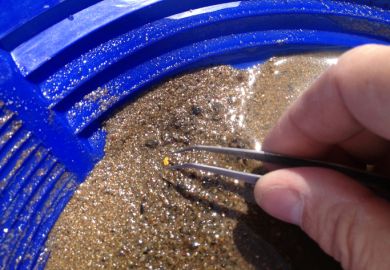Peter Medawar once said that no scientist should indulge in the writing of scientific history but that, if the urge is too great, the enterprise should be deferred until well after the mandatory retirement age. In this book of historical essays in the field of neuroscience, Charles Gross proves him wrong - well, almost.
Gross is an eminent professor of neuroscience at Princeton and has made no small contribution to the field. He has collected in this volume five essays that have been published elsewhere. Collectively, they reveal a man of erudition with a passion for his subject. All but the last are intelligible to the lay person and two are thrilling. The first one is a somewhat dry and factual account of brain studies from the earliest Egyptian days to recent decades, when physiologists began profaning the secrets of the cerebral cortex with their electrodes. Perhaps the most surprising impression to emerge from these pages is how dull and lacking in imagination scientists can be, and often are, and how easily they can succumb to the perils of superstition. It took a long time to convince many of them that the brain, rather than the blood, the diaphragm or the heart, is the seat of higher mental functions, intelligence, ability and much else that we now associate with it. Plato, whom Gross surprisingly refers to as "one of the most important ideological opponents of natural science of all time", saw the importance of the brain in higher mental activities, while his more "scientific" student, Aristotle, did not.
Why should Aristotle, who had dissected so many animals, have come to such an unsatisfactory conclusion about the brain? Gross writes: "The two champions of the hegemony of the brain, Alcmaeon and Hippocrates, were both practising physicians. The evidence that both gave in support of their opinions was strictly clinical", whereas Aristotle had confined himself to zoological dissection and observation. This is an early version of what was to happen over and over again, namely that behavioural results obtained through controlled experimental lesions in the brains of animals have been one of the worst guides to the organisation of the brain. We have consistently had far better information from clinical studies in the human and from electrophysiological studies in animals.
That dissection, experimentation and detailed study are not the only paths to understanding the functioning of the brain, or indeed of any other organ, are wonderfully contrasted in two separate chapters, one dealing with the great Leonardo and the other with the much less well-known Emanuel Swedenborg, although the contrast is one that the reader will have to discover, since it is not mentioned in the book. Even in spite of his many dissections and detailed studies, Leonardo ended up with some bizarre conjectures about the role of the different parts of the brain. Swedenborg, on the other hand, reached more insightful conclusions about the brain almost entirely by reading and thinking, and without the aid of all these dissections. A spiritual and religious Swede who eventually found refuge in London, Swedenborg influenced many men of letters, including Balzac and Strindberg, but his influence on the development of neuroscience was insignificant, partly because he was so far head of his time and partly because, Gross tells us, "As a neuroscientist, Swedenborg failed to publish, and as a neuroscientist he certainly perished." Gross deserves credit for re-establishing this figure. There is also a lesson from reading this chapter and comparing it with the previous two - that it is better to be a thinker who does not experiment than an experimentalist who does not think.
The fourth essay, on the hippocampus minor, or man's place in nature, is a brilliantly written and thrilling piece, an intellectual detective story that is hard to put down. Much of it revolves around the debate on evolution following publication of Darwin's The Origin of Species . But it is more than that - it is also a study of two different scientific personalities in class-conscious Britain. Much of the debate revolved around the attempt to demonstrate that the human brain contained structures that no other brain contained and one structure - the hippocampus minor - played a central role. To establish through this his point that man and apes could not have had a common descent, Sir Richard Owen was prepared to resort to dishonesty, not only in his publications but even in describing his posts in medical directories. He became easy prey to the more brilliant T. H. Huxley, who in his relentless effort to establish the evolutionary doctrine of Darwin on the one hand and settle his grudge against Owen on the other, exploited the weaker intellect's errors.
Perhaps the weakest chapter is the last. For even after Gross says that the account given here, of the visual parts of the brain beyond the primary visual cortex, is highly personal and autobiographical, one is still left with the uncomfortable feeling that the contributions that he and his colleagues have made lose much of their weight when not seen in a more general context. This concentration on the efforts of Gross and a few who have been linked to him has the drawback that it gives an account of the visual brain outside the primary visual cortex that is so partial and imperfect that it has limited use as history or as a guide to the functions and functioning of the visual brain.
The human qualities that emerge - such as the diffidence in the statement that "Perhaps because of the general scepticism, we did not ourselves publish a full account of a face-selective neuron until 1981 (after which) a flood of papers on such cells appeared'' combined with the joy that "Our basicI findings were also confirmed'' - though commendable, do little to inject into these pages the sense of the importance of their findings in general, which could only have been done if this body of work had been viewed in a broader context. There is finally an unfairness towards others in the statement that the "motor command'' hypothesis is "quite wrong''. This hypothesis supposes that some cells in the parietal cortex are not driven by purely visual stimuli but require the organism to undertake a motor response directed towards the visual stimulus. To my knowledge, no one has found it to be wrong.
Despite these shortcomings, the first four chapters, and especially the brilliant fourth one, make this book one that every neuroscientist and anyone interested in the development of ideas in general, and ideas about the brain in particular, should buy, read and enjoy.
Semir Zeki is professor of neurobiology, University College London.
Brain, Vision, Memory: Tales in the History of Neuroscience
Author - Charles G. Gross
ISBN - 0 262 07186 X
Publisher - MIT Press
Price - £22.50
Pages - 255



